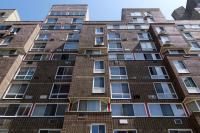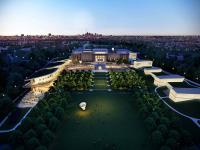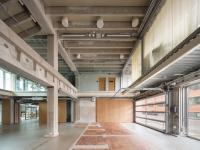ROKI Global Innovation Center
Shizuoka, Japan
ROGIC (ROKI Global Innovation Center) is a research and development facility focusing on products from ROKI, a company located in Hamamatsu that provides automotive filtration technology. This project was started to create a leading eco-friendly office that would convert the company’s filtration technology thinking into building form while both using natural energy and increasing intellectual productivity, and in an effort to maximize effective use of its location: surrounded by mountains, with the Tenryu River flowing south. It was also selected as a project to be adopted by the Model Project for Promoting CO2 Reduction in Houses and Buildings, sponsored by Japan’s Ministry of Land, Infrastructure, Transport, and Tourism.
The pillarless office spreads out under an enormous roof to create various environmental nuances, thanks to semi-outdoor offices provided by large sliding doors and a multi-tiered, single room layout that is three-dimensionally tiered yet provides partitioned space.
The massive roof, with a hybrid wood and steel truss spanning the entire building, serves as a filtration roof and functions as a route for light and wind as well. The finished side uses ROKI’s filter, which is used in automotive air filters, to diffuse strong light and create a bright office space filled with natural light but no glare.
The interior is an original design using only the finest natural materials, with a Japanese paper-like filter ceiling, wooden flooring, plastered walls, and cedar wood furniture.
First, we conducted an environmental survey of the surrounding area over the course of one year, after which we decided on a placement that would utilize natural energy, building shape, landscaping, and facility planning. The breeze coming from the magnificent Tenryu River and from the forest lowers the temperature of the surrounding area by 1.5°C. The use of earth tubes can bring in air from outside that has been cooled by as much as 6.5°C, and in winter it can bring in air that has been warmed by 0.5°C.
The building uses a Building Environment and Energy Management System to calculate effective temperature from outside temperature and other conditions. Opening the windows and skylights will cause the system to react and shut down the air conditioning system for the office area. Using the knowledge that people in environments approaching outdoors have a wider permissible range of thermal environments, the building extends the mid-cycle by 1.8 times and proactively uses natural filtration. This is expected to cut the heating and cooling load by 52%. Further, by having a fully lit ceiling, researchers in the office can not only feel the changes in the outside environment, but they also do not need artificial lighting during the day. This creates an office that can eliminate 30 to 35% of the energy for lighting that a standard office requires, and therefore greatly reduces CO2 output.
Engineers working at ROGIC can not only seamlessly experience one day’s worth of natural brightness without any uneasiness, they can also feel comfortable with changes in the natural environment while inside the building.
This brings back the sensitivities of Japanese people, who grow up with natural human feelings and the four seasons, and welcomes the birth of explosive research results and discoveries.

















